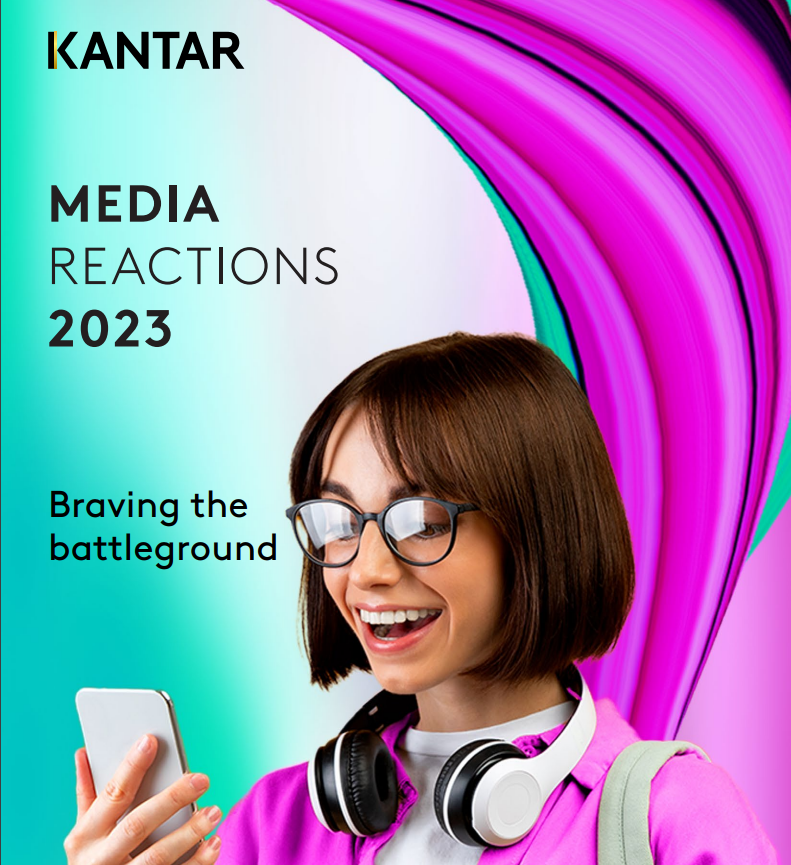The latest Kantar Media Reactions report analyzing consumer and marketer attitudes highlights significant gaps in media preferences. Consumers strongly favor in-person channels while marketers concentrate budgets on digital video. We summarize key insights from the global study.
For the 2023 edition, Kantar surveyed 16,000 consumers across 23 markets and 900 marketers worldwide. The results reveal diverging priorities and attitudes, underscoring the need for data-driven strategy.
Top-ranking media brands
| Consumers | Marketers | ||
| 1 | Amazon (-) | 1 | YouTube (+2) |
| 2 | Google (+2) | 2 | Google (-) |
| 3 | TikTok (-1) | 3 | Instagram (-2) |
| 4 | Instagram (+2) | 4 | TikTok (-) |
| 5 | Spotify (-2) | 5 | Spotify (-) |
Top-ranking media channels
| Consumers | Marketers | ||
| 1 | Sponsored events (-) | 1 | Online video (-) |
| 2 | Cinema ads (+1) | 2 | Sponsored events (-) |
| 3 | Out of home (+3) | 3 | Digital out of home (+2) |
| 4 | Point of sale (-) | 4 | Video streaming ads (+2) |
| 5 | Digital out of home (-) | 5 | Online stories ads (+2) |
Consumers Prefer In-Person and Interruption-Free Touchpoints
Sponsored events topped consumers’ rankings for the second straight year as digital seamlessly blends into real-world experiences. The rest of the top five all encompass in-person engagement: cinema ads, out-of-home, point of sale, and digital out-of-home.
This aligns with our previous analysis showing strong consumer receptivity for out-of-home and DOOH advertising. It provides a more impactful canvas for creativity compared to interruptive digital ads.
Meanwhile, marketers’ preferences skew heavily toward digital video. Online video ranks first again, followed by streaming video ads and social media stories. Traditional TV is shockingly absent from their top five.
The Amazon Effect Reshapes Commerce Advertising
Amazon claimed the #1 spot for global consumer ad preference for the second consecutive year. Its ads are seen as useful and relevant. Trust also grew nearly 10% among both consumers and marketers.
As highlighted in our prior coverage, Amazon’s evolution into an advertising powerhouse is driven by its unparalleled reach and purchase-oriented targeting capabilities. While not yet a top choice for marketers, Amazon advertising is gaining momentum.
YouTube Overtakes Instagram Among Marketers
YouTube surged two spots to lead marketer preferences thanks to a 6% increase in trust. Our previous analysis noted YouTube’s focus on brand safety, transparency and contextual targeting to build confidence.
Instagram dropped two places among marketers despite improving among consumers. Lower innovation perceptions caused the fall. But both groups agree TikTok is the most attention-grabbing media brand.
TV Declines While Metaverse Fails to Gain Traction
TV’s importance plunged among marketers with lower trust and innovation scores. Just 6% plan TV budget increases for 2024 as audiences shift.
Metaverse marketing also failed to meet inflated expectations. Only 12% actually increased spend versus 61% who planned to last year. Just 22% now expect to boost metaverse budgets in 2023.
And Twitter’s rebrand to X damaged its reputation. It now ranks negatively for marketer preference as trust and innovation declined.
Key Lessons for Closing Perception Gaps
Kantar’s analysis highlights critical gaps between consumer and marketer attitudes. Key takeaways include:
- Leverage in-person channels to drive brand impact and avoid interruptions
- Prioritize attention – cinema, events and DOOH grab focus for both groups
- Build digital video expertise but remain flexible as preferences evolve
- Rely on data and insights like Media Reactions to inform strategy
With consumers valuing different media attributes than marketers, ongoing research is essential. Companies that align strategies to actual receptivity and attention stand to gain advantage.
